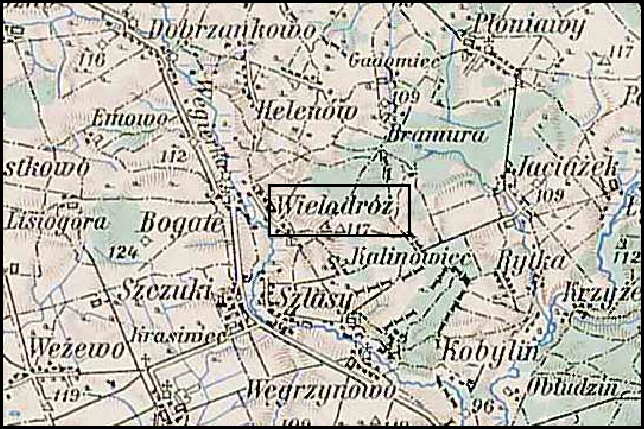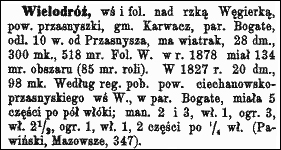The village of Wielodróz is significant in my family history because it was the location where Katarzyna Mossakowska, the wife of my cousin Aleksander Chodkowski was born.
Austrian Military Map of the Wielodróz Area – 1910
SOURCE: Third Military Mapping Survey of Austria-Hungary, Sheet 39-53, Ostrleka. Online http://lazarus.elte.hu/hun/digkonyv/topo/200e/39-53.jpg; downloaded 22 Jul 2010.
Słownik Geograficzny Entry for Wielodróz
Source: Chlebowski, Bronisław, Filip Sulimierski, and Władysław Walewski, eds., Słownik Geograficzny Królestwa Polskiego i Innych Krajów Słowiańskich (Geographical Dictionary of the Kingdom of Poland and other Slavonic Countries) – Warsaw 1893, Volume XIII, page 358.
Click on the link for a PDF copy of the Słownik Geograficzny entry for Wielodróz. Translated from the Polish, the entry reads:
Wielodróz,a village and grange [large manorial farmstead] on the river Węgierka, Przasnysz Powiat, Karwacz Gmina, and Bogate Parish, 10 versts [0.66 miles per verst] from Prazasnysz. It has a windmill, 28 homes, 300 residents, 518 morgs [in the Russian partition 1 morg = 1.388 acres]. In the year 187, the Wielodróz grange had 134 morgs of territory (85 morgs of soil). In the year 1827 there were 20 homes and 98 residents. According to the Notary Public for the Ciechanów-Przasnysz Powiats, the village of Wielodróz in the Bogate Parish had 5 parts per ½ włóka [1 włóka = about 30 morgs], man. 2 and 3, 1 włóka; 3 gardens, 2 ½ włóki; 1 garden, 1 włóka; 2 parts per ½ włóka. (Pawiński, Mazowsze, 347).
The notation (Pawiński, Mazowsze, 347) refers to:
Pawiński, Adolf. 1892. Mazowsze. Polska XVI wieku pod względem geograficzno-statystycznym, t. 5. Warszawa: skł. gł. w Księgarni Gebethnera i Wolffa.
This publication is available online at the Digital Library of Wielkopolska.
The maps of the Third Military Mapping Survey of Austria-Hungary and the entries in the Słownik Geograficzny were prepared at about the same time and make a good pair for studying places in and around the Congress Kingdom of Poland at the end of the 19th century and beginning of the 20th century, a time period when the Eastern European ancestors of present-day Americans left their homelands for the United States.
Copyright © 2010 by Stephen J. Danko





